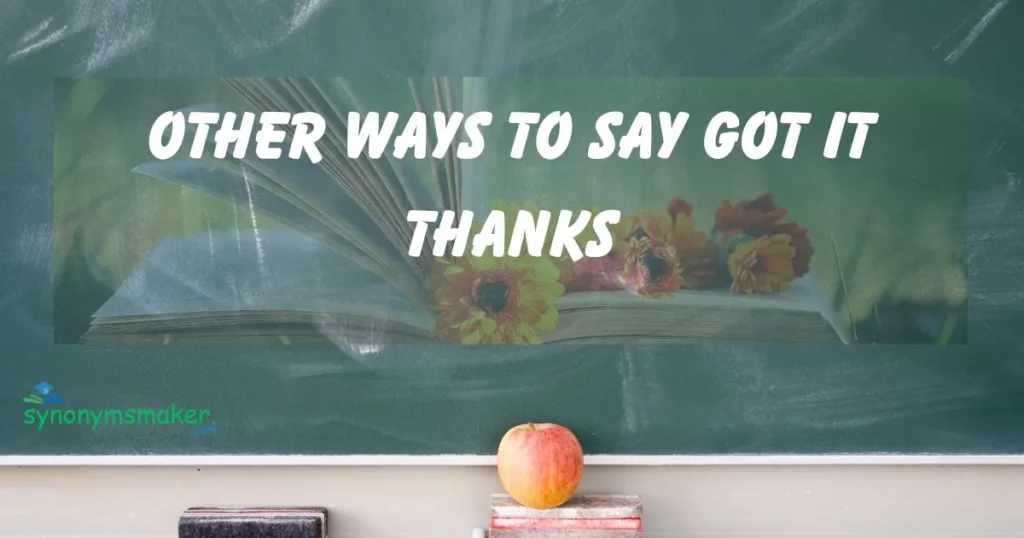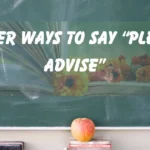While “Got it, thanks” is quick and common, it can sound too casual or repetitive—especially in work emails, team chats, or client replies. Using more thoughtful, clear, and context-aware alternatives shows you’re not only paying attention but also value the exchange. Learn how to say “Got it, thanks” in more expressive, professional, and situationally appropriate ways.
Whether you want to sound polished, friendly, or efficient, upgrading your response makes a difference in how you’re perceived. This guide will help you choose more professional, polite, and personalized alternatives to “Got it, thanks” across casual, formal, and workplace conversations.
Synonyms for “Got It Thanks”
- Understood, thank you
- Noted, thanks
- Thanks, I’ve got it
- All clear, thank you
- Copy that, thanks
- Message received
- Appreciate the update
- Acknowledged, thanks
- Okay, got it
- Heard you, thank you
- Thanks for letting me know
- Got the info, thanks
- Clear, thank you
- I’m on it, thanks
- Thanks, understood
- Noted with thanks
- Cheers, got it
Understood, Thank You
When you say understood, thank you, you’re confirming not just that you’ve received a message—but that you’ve fully grasped its meaning. This phrase is clear, direct, and polite, making it suitable for nearly any situation where understanding is key. Whether you’re responding to instructions, a reminder, or even constructive feedback, this reply communicates respect and attentiveness.
It’s often used in workplace emails, project discussions, or text replies when clarity matters. It helps to avoid back-and-forth conversations because it lets the other person know there’s no confusion.
Adding “thank you” softens the phrase and makes it warmer. It shows that you’re not just acknowledging the information—you also appreciate the effort someone made to share it with you.
It’s especially useful when you’re dealing with complex topics. It keeps communication clean and efficient, which is valuable in both personal and professional settings.
Overall, this phrase shows that you are focused, receptive, and ready to move forward with full understanding.
Noted, Thanks
Saying noted, thanks is a brief but effective way to confirm receipt of a message. It’s often used in written conversations to indicate that you’ve read and recorded important points, especially when no follow-up is needed. The word “noted” itself implies that you’ve made a mental or written note of the information.
This phrase is widely used in professional environments—whether you’re responding to meeting notes, task updates, or team reminders. It signals competence and organization without being overly formal.
Including “thanks” helps add a touch of politeness and gratitude, even in the most routine exchanges. It balances brevity with professionalism.
“Noted, thanks” helps reduce inbox clutter and unnecessary follow-ups. It lets the sender know that you’re alert, present, and have retained the information.
In many ways, it’s the gold standard of short, respectful acknowledgments for busy teams and thoughtful conversations.
Thanks, I’ve Got It
With thanks, I’ve got it, you’re delivering a confident acknowledgment that feels both personal and relaxed. This phrase is perfect when you want to show that you’ve fully received and understood the message, and you’re ready to take it from here.
It’s especially useful when someone goes out of their way to explain something or sends a detailed message. By using this phrase, you’re confirming that you don’t need further clarification and appreciate their effort.
This reply also shows a level of independence. You’re letting the person know they’ve done their part—and you’re now capable of handling your side without issue.
The phrase feels approachable, especially in collaborative settings. It encourages open communication while still respecting each other’s time and contributions.
“Thanks, I’ve got it” is a great way to close a loop in conversation while sounding both professional and friendly.
All Clear, Thank You
When you say all clear, thank you, you’re confirming that everything has been understood with no confusion or doubt. It’s often used after someone explains something or when a misunderstanding has been resolved.
This phrase is reassuring. It lets others know that the message came through successfully and you’re now on the same page moving forward.
It’s ideal in high-stakes or detail-oriented communication—such as project updates, revised instructions, or technical processes. It reflects a tone of readiness and clarity.
Adding “thank you” adds a nice, human element to an otherwise straightforward phrase. It makes the response feel warmer and more courteous.
When things need to run smoothly, this phrase is a strong way to confirm that you’re aligned and nothing is left hanging.
Copy That, Thanks
The phrase copy that, thanks is short and efficient, often used in team settings or casual workplace chats. It originally comes from radio communication, where “copy that” simply meant “I heard and understood.”
Today, it’s a practical and slightly casual way to show that you’re in sync with what’s been shared. It suggests that you’re actively listening and can now proceed accordingly.
The phrase is especially useful in fast-paced environments where there’s no time for long replies. Adding “thanks” keeps it polite and friendly.
It helps eliminate misunderstandings and reassures the sender that their message has been fully received and actioned if necessary.
If you’re looking for a phrase that’s both direct and warm, this is a go-to option for quick, clear communication.
Learn More: Other Ways to Say “Dream Come True”
Message Received
Using message received is a confident way to confirm that you’ve acknowledged what was sent—especially in formal or high-volume communication settings.
It’s a favorite among professionals because it doesn’t require unnecessary dialogue. It simply closes the communication loop by signaling full awareness of the message.
This phrase is helpful when you’re working remotely, handling large teams, or managing multiple conversations at once. It shows you’re engaged, responsive, and alert.
Though brief, the tone is firm and professional. It’s often used when the next step is already known or underway.
It’s a phrase that says, “I’ve seen it. You don’t need to worry. I’m already on it,”—a clear indicator of competence and communication discipline.
Appreciate the Update
Saying appreciate the update is a thoughtful and respectful way to acknowledge that someone has taken time to share new information with you. It shows that you value being kept in the loop and don’t take updates for granted. This phrase fits well in both professional and casual situations—whether it’s a project revision, schedule change, or even a status check-in.
It’s often used in email replies, Slack messages, or quick responses when someone gives you progress updates. By choosing this phrase, you communicate that their effort in keeping you informed is recognized and appreciated.
This response can also help build trust over time. When you consistently acknowledge updates with gratitude, people feel more motivated to keep you informed—leading to better collaboration and fewer misunderstandings.
It works well when no action is needed on your end, but you still want to show that you received the message and took it seriously. It keeps communication respectful and proactive without overcomplicating things.
Whether you’re responding to a client, colleague, or teammate, saying “appreciate the update” sends a clear signal of professionalism, gratitude, and presence.
Acknowledged, Thanks
The phrase acknowledged, thanks is precise, formal, and ideal when you want to confirm that a message has been seen and logged—especially in structured or task-heavy settings. It often appears in technical teams, administrative updates, and professional reports where acknowledgment is required but doesn’t call for a discussion.
This is a direct and efficient way of responding without sounding cold. The addition of “thanks” makes it more polite and professional, showing that you are both attentive and appreciative.
This phrase is also useful in managing large volumes of communication. It avoids unnecessary back-and-forth while still ensuring that the sender feels heard and respected.
It works well when you’re confirming instructions, policy updates, or decisions. By using “acknowledged,” you eliminate any doubt about whether the message has been properly received and understood.
This response communicates that you’re disciplined, responsive, and ready to act on what’s been shared.
Okay, Got It
The phrase okay, got it is casual, clear, and widely used in both personal and professional spaces. It tells the sender you’ve not only received the message but understand what’s required or being shared. It’s confident, concise, and conversational.
This phrase is perfect for quick replies where you want to keep communication flowing but still show that you’re paying attention. It works especially well in messaging platforms like WhatsApp, Microsoft Teams, or Slack.
It has a relaxed tone, which can be great when working with peers or close collaborators. It shows you’re easy to work with while still being attentive and efficient.
“Got it” also signals a sense of readiness. It means you’re mentally prepared to move ahead with whatever’s been discussed, making you seem reliable and present.
If you’re looking for a phrase that’s casual yet trustworthy, “okay, got it” offers the perfect balance of clarity and approachability.
Heard You, Thank You
When you say heard you, thank you, you’re letting someone know that their voice or message was truly received and understood on a personal level. This phrase brings empathy into acknowledgment—it doesn’t just confirm a message, it confirms that someone’s effort to speak was recognized.
It’s especially helpful in emotionally charged or sensitive situations, where someone might need to feel validated and respected, not just acknowledged.
This phrase can also be powerful in one-on-one conversations, giving the other person a sense of being seen and appreciated, rather than brushed aside.
It’s useful not only in personal discussions but in team settings as well, where emotional intelligence matters. Saying “heard you” builds emotional safety and connection.
By adding “thank you,” the phrase becomes even more gracious. It turns a reply into something calming, kind, and reflective of deeper engagement.
Thanks for Letting Me Know
Saying thanks for letting me know is one of the most commonly used—and widely appreciated—phrases in daily communication. It combines gratitude and acknowledgment in a way that feels genuine, simple, and human.
It’s perfect when someone shares important information that might affect your plans, decisions, or thoughts. Whether it’s a small update or something more serious, this phrase shows that you’re open, thankful, and responsive.
It helps maintain healthy and respectful conversations. People like to feel that their effort in updating you is recognized, even if the message itself was minor or routine.
This phrase fits into almost every context—family, friends, coworkers, clients. It’s versatile, warm, and polite, making it ideal for both formal and informal communication.
Using this phrase consistently builds a tone of cooperation and appreciation in all types of relationships, whether personal or professional.
Got the Info, Thanks
Saying got the info, thanks is a quick and friendly way to confirm that you’ve received the information and that no further clarification is needed. It’s especially helpful when someone shares a link, file, instruction, or important update, and you want to show that you’re paying attention and ready to proceed.
This phrase keeps conversations moving forward without overexplaining. It’s direct and efficient, yet the “thanks” adds a layer of appreciation that makes it sound warm and human.
It’s useful in both formal and casual work settings—whether you’re replying to a manager, colleague, or client. The phrase is brief but still manages to express gratitude and clarity at once.
You can also use it when multiple people are involved in a thread or project. It lets everyone know you’re up to speed and fully informed.
By using this phrase regularly, you create a reliable communication style that shows you’re responsible, responsive, and appreciative of others’ effort.
Clear, Thank You
When you say clear, thank you, you’re confirming that everything is now fully understood with no confusion remaining. It’s a reassuring phrase, particularly after someone provides clarification, detailed instructions, or answers your questions.
This response is especially useful in projects or meetings where information can easily become overwhelming. Saying “clear” lets the sender know that the message made sense and you’re ready to move ahead confidently.
It’s respectful without being too formal, and it encourages smooth communication in both one-on-one and group settings. It shows that you’ve listened carefully and appreciate the effort taken to explain something.
This phrase can also save time. Instead of diving into more unnecessary back-and-forth, “clear, thank you” wraps up the point neatly and shows you’re mentally organized.
It reflects calm confidence, clarity, and a positive, cooperative attitude—qualities that go a long way in any relationship.
I’m On It, Thanks
Saying I’m on it, thanks is a powerful way to show readiness and ownership. It confirms not just that you’ve received the task or message, but that you’re already taking action or planning to follow through right away.
This phrase adds energy and decisiveness to your reply. It’s perfect for work chats, team updates, or emails where promptness and accountability are key.
The phrase also builds trust. When others hear that you’re “on it,” they feel confident that the task will be handled without delay or confusion.
Adding “thanks” shows you appreciate the message, instruction, or reminder. It keeps the tone positive and helps create an atmosphere of mutual respect and productivity.
Overall, it’s a confident, solution-focused phrase that makes you sound engaged, dependable, and action-oriented.
Thanks, Understood
The phrase thanks, understood is short but strong. It communicates both comprehension and appreciation—a valuable combination when clarity matters. You’re saying you’ve received and fully grasped the information, while also thanking the sender for sharing it with you.
It’s great for workplace communication, especially when responding to detailed emails, schedules, or collaborative updates. It cuts through the noise and lets others know you’re ready to move forward.
This phrase balances efficiency with warmth. It avoids sounding robotic, thanks to the added “thanks,” which keeps the tone friendly and team-centered.
You can also use it in more sensitive communication, where confirming that you’ve understood the tone, not just the content, matters deeply.
It’s a go-to acknowledgment that builds trust, reflects humility, and shows that you’re clear-headed, courteous, and aligned with what was shared.
Noted with Thanks
When you say noted with thanks, you’re expressing that the information has not only been received but also recorded and appreciated. It’s a slightly more formal version of “got it” that works wonderfully in professional emails and client communications.
It’s often used when someone sends you feedback, requirements, or approval. It lets them know you’ve made a mental or actual note of the message and are treating it seriously.
The “with thanks” portion softens the response and adds grace. It shows that you value what was shared and you’re not taking the update for granted.
This phrase is especially useful when someone goes out of their way to provide help or clarification—it shows respect and keeps relationships positive and communicative.
Use this phrase to position yourself as someone who’s not just organized, but also gracious and appreciative in every exchange.
Learn More: Other Ways to Say Enjoy Your Stay
Cheers, Got It
Using cheers, got it brings a casual, friendly tone to your acknowledgment. It’s great for team communication, peer-level emails, or informal chats where you want to confirm that you’re in the loop—without sounding stiff or overly formal.
“Cheers” adds a warm, approachable vibe that’s common in many English-speaking cultures. Paired with “got it,” the phrase becomes both inviting and action-ready.
This expression is ideal for when the message is clear, simple, or informal—like scheduling updates, shared files, or quick task reminders.
It’s especially useful in global teams where keeping things friendly but focused is important. This phrase shows you’re easy to talk to while still being efficient and engaged.
Using “cheers, got it” regularly helps build a tone of cooperation, lightness, and mutual respect in everyday communication.
Real Life Examples and Scenarios
1. Scenario: Replying to a Manager Who Sent Instructions
Your manager sends you a task breakdown for the week.
Example:
“Thanks for the details—I’ll move forward accordingly.”
2. Scenario: Responding to a Client Who Shared Feedback
A client reviews your proposal and suggests a few edits.
Example:
“Understood! I’ll make those changes and get back to you shortly.”
3. Scenario: Chatting with a Coworker on Slack
Your teammate explains how to use a tool you’re new to.
Example:
“Perfect—thanks for the heads-up, I’m on it now.”
4. Scenario: Confirming Receipt of a Document from HR
HR sends you the finalized version of a contract.
Example:
“Received with thanks. I’ll keep it for my records.”
5. Scenario: Casual Message to a Friend or Peer
A friend sends you the address for an event this weekend.
Example:
“Awesome, appreciate it! See you there.”
Conclusion
While “Got it, thanks” gets the message across, using more clear, genuine, or professionally tuned alternatives makes your reply more impactful. Whether you’re confirming task details, acknowledging feedback, or responding to casual chats, the right phrase can show both attentiveness and tone-awareness.
From “Understood, thanks for the info” to “Appreciate the update!”, each variation helps build trust and keep communication smooth. Next time you feel the urge to default to “Got it, thanks,” try using words that reflect your professionalism, personality, or the situation’s tone—you’ll leave a better impression every time.

Hi, I’m Adrian Steele, the admin of synonymsmaker.com. I’m passionate about language and dedicated to providing you with the best experience in discovering synonyms and expanding your vocabulary. Feel free to share your ideas or feedback with me. I’m always open to hearing from you!



